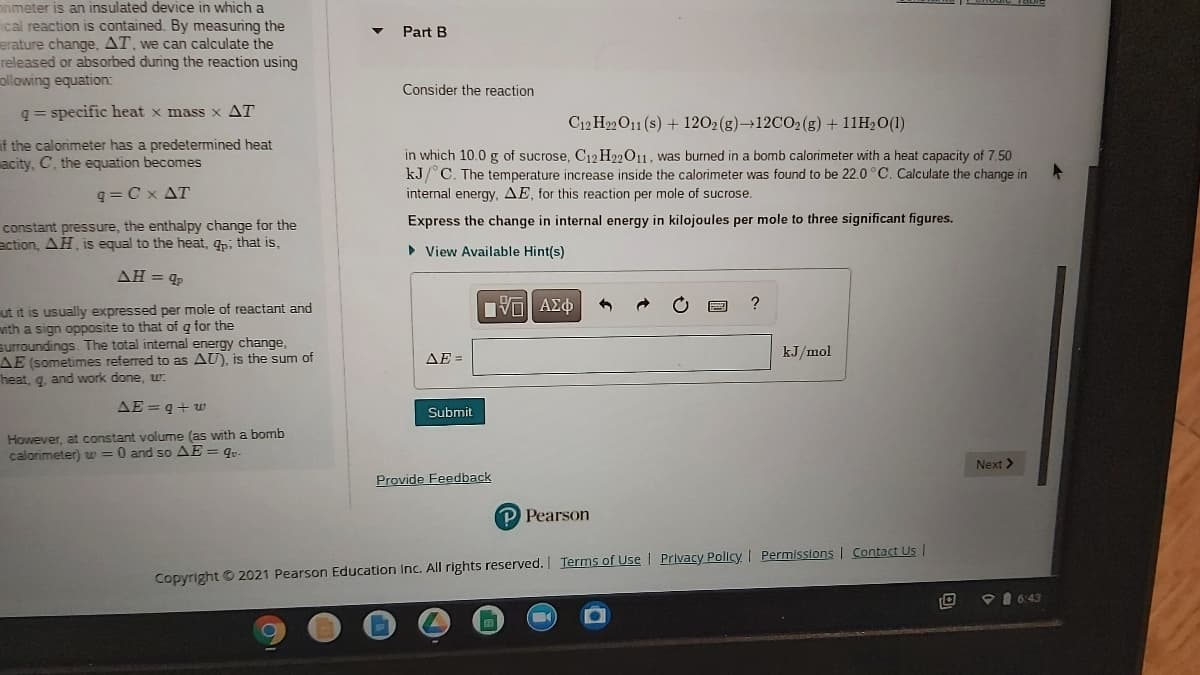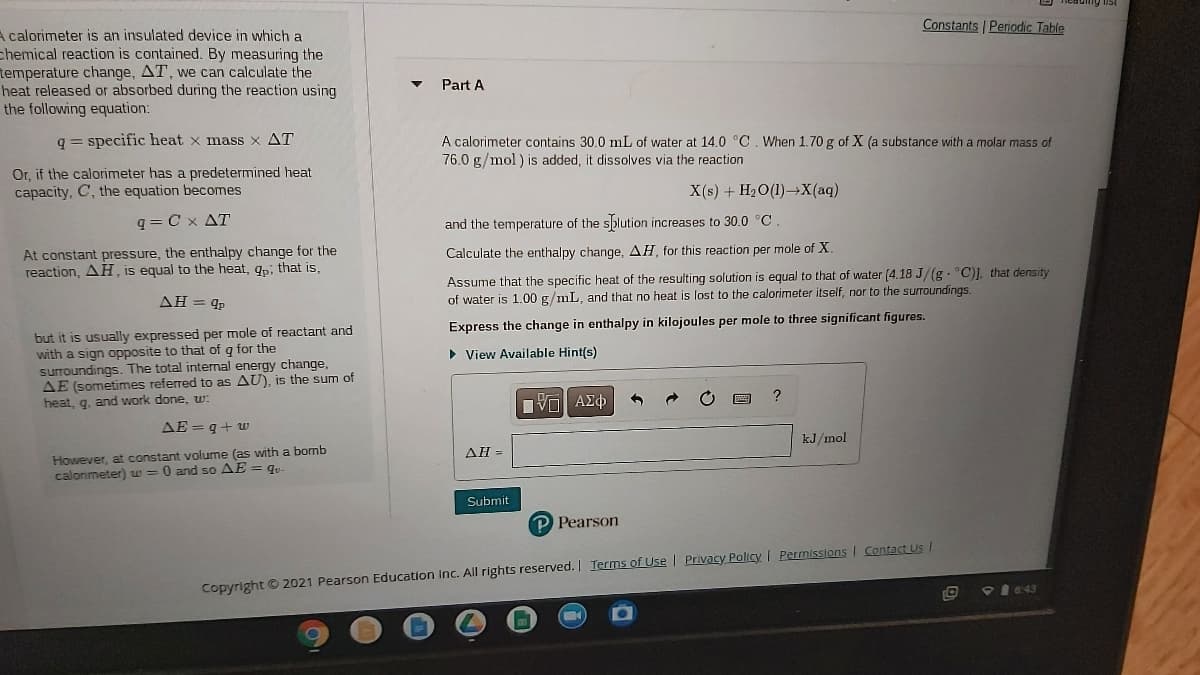Consider the reaction C12 H22O11 (s) + 1202(g)→12CO2 (g) + 11H,0(1) in which 10.0 g of sucrose, C12 H22O11, was burned in a bomb calorimeter with a heat capacity of 7.50 kJ/ C. The temperature increase inside the calorimeter was found to be 22.0°C. Calculate the change in internal energy, AE, for this reaction per mole of sucrose. Express the change in internal energy in kilojoules per mole to three significant figures. • View Available Hint(s) ? kJ/mol AE = Submit
Consider the reaction C12 H22O11 (s) + 1202(g)→12CO2 (g) + 11H,0(1) in which 10.0 g of sucrose, C12 H22O11, was burned in a bomb calorimeter with a heat capacity of 7.50 kJ/ C. The temperature increase inside the calorimeter was found to be 22.0°C. Calculate the change in internal energy, AE, for this reaction per mole of sucrose. Express the change in internal energy in kilojoules per mole to three significant figures. • View Available Hint(s) ? kJ/mol AE = Submit
Chemistry for Engineering Students
4th Edition
ISBN:9781337398909
Author:Lawrence S. Brown, Tom Holme
Publisher:Lawrence S. Brown, Tom Holme
Chapter9: Energy And Chemistry
Section: Chapter Questions
Problem 9.101PAE
Related questions
Question

Transcribed Image Text:onmeter is an insulated device in which a
ical reaction is contained. By measuring the
erature change, AT, we can calculate the
released or absorbed during the reaction using
ollowing equation:
Part B
Consider the reaction
q = specific heat x mass x AT
C12 H22011 (s) + 1202(g)→12CO2(g) + 11H20(1)
if the calorimeter has a predetermined heat
acity, C, the equation becomes
in which 10.0 g of sucrose, C12 H22011, was burned in a bomb calorimeter with a heat capacity of 7.50
kJ/°C. The temperature increase inside the calorimeter was found to be 22.0 °C. Calculate the change in
internal energy, AE, for this reaction per mole of sucrose.
q = C x AT
Express the change in internal energy in kilojoules per mole to three significant figures.
constant pressure, the enthalpy change for the
action, AH, is equal to the heat, qp; that is,
• View Available Hint(s)
AH = 9p
Vα ΑΣφ
ut it is usually expressed per mole of reactant and
with a sign opposite to that of q for the
surroundings. The total internal energy change,
AE (sometimes referred to as AU), is the sum of
heat, g, and work done, w.
kJ/mol
AE =
AE =q+ w
Submit
However, at constant volume (as with a bomb
calorimeter) w = 0 and so AE= g..
Next >
Provide Feedback
P Pearson
Copyright © 2021 Pearson Education Inc. All rights reserved. Terms of Use | Privacy Policy I Permissions| Contact Us |
VI 6:43

Transcribed Image Text:A calorimeter is an insulated device in which a
chemical reaction is contained. By measuring the
temperature change, AT, we can calculate the
heat released or absorbed during the reaction using
the following equation:
Constants Periodic Table
Part A
q = specific heat x mass x AT
A calorimeter contains 30.0 mL of water at 14.0 °C. When 1.70 g of X (a substance with a molar mass of
76.0 g/mol ) is added, it dissolves via the reaction
Or, if the calorimeter has a predetermined heat
capacity, C, the equation becomes
X(s) + H2O(1)→X(aq)
q=C x AT
and the temperature of the sblution increases to 30.0 °C
At constant pressure, the enthalpy change for the
reaction, AH, is equal to the heat, qp; that is,
Calculate the enthalpy change, AH, for this reaction per mole of X.
Assume that the specific heat of the resulting solution is equal to that of water (4.18 J/(g. °C)J, that density
of water is 1.00 g/mL, and that no heat is lost to the calorimeter itself, nor to the suroundings.
ΔΗp
Express the change in enthalpy in kilojoules per mole to three significant figures.
but it is usually expressed per mole of reactant and
with a sign opposite to that of q for the
surroundings. The total internal energy change,
AE (sometimes referred to as AU), is the sum of
heat, g. and work done, w:
• View Available Hint(s)
να ΑΣφ
?
AE=q+ uw
kJ/mol
However, at constant volume (as with a bomb
calorimeter) w = 0 and so AE = qu-
ΔΗ-
Submit
Pearson
Copyright © 2021 Pearson Education Inc. All rights reserved. Terms of Use | Privacy Policy I Permissions I Contact Us /
VI6 43
Expert Solution
This question has been solved!
Explore an expertly crafted, step-by-step solution for a thorough understanding of key concepts.
This is a popular solution!
Trending now
This is a popular solution!
Step by step
Solved in 3 steps with 2 images

Recommended textbooks for you

Chemistry for Engineering Students
Chemistry
ISBN:
9781337398909
Author:
Lawrence S. Brown, Tom Holme
Publisher:
Cengage Learning

Chemistry: Principles and Practice
Chemistry
ISBN:
9780534420123
Author:
Daniel L. Reger, Scott R. Goode, David W. Ball, Edward Mercer
Publisher:
Cengage Learning

Chemistry by OpenStax (2015-05-04)
Chemistry
ISBN:
9781938168390
Author:
Klaus Theopold, Richard H Langley, Paul Flowers, William R. Robinson, Mark Blaser
Publisher:
OpenStax

Chemistry for Engineering Students
Chemistry
ISBN:
9781337398909
Author:
Lawrence S. Brown, Tom Holme
Publisher:
Cengage Learning

Chemistry: Principles and Practice
Chemistry
ISBN:
9780534420123
Author:
Daniel L. Reger, Scott R. Goode, David W. Ball, Edward Mercer
Publisher:
Cengage Learning

Chemistry by OpenStax (2015-05-04)
Chemistry
ISBN:
9781938168390
Author:
Klaus Theopold, Richard H Langley, Paul Flowers, William R. Robinson, Mark Blaser
Publisher:
OpenStax

Chemistry
Chemistry
ISBN:
9781305957404
Author:
Steven S. Zumdahl, Susan A. Zumdahl, Donald J. DeCoste
Publisher:
Cengage Learning


Chemistry: An Atoms First Approach
Chemistry
ISBN:
9781305079243
Author:
Steven S. Zumdahl, Susan A. Zumdahl
Publisher:
Cengage Learning